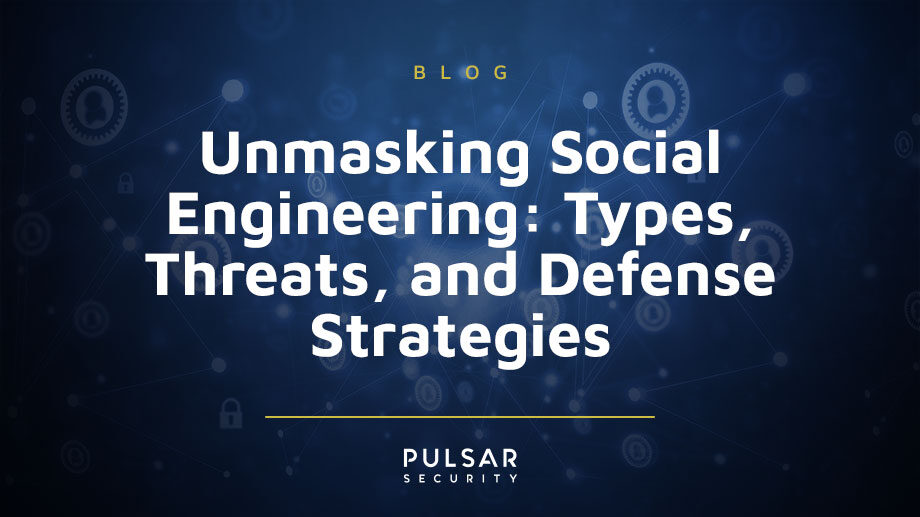Unmasking Social Engineering Types, Threats, and Defense Strategies
Social engineering poses a considerable threat in the current-day cybersecurity landscape. By preying on human psychology, social engineering allows threat actors to gain unauthorized access to an organization’s sensitive information. According to Verizon, 68% of cybersecurity threats involve social engineering. Social engineering manipulates individuals into handing over sensitive information or partaking in actions compromising security. Hackers exploit trust, authority, and urgency, amongst other psychological triggers, to deceive and exploit their targets.
This article explains various types of social engineering and discusses some techniques to mitigate the significant social engineering techniques. Social engineering is often only one piece of a complete network compromise, but it can be devastating for a company once paired with other hacking techniques.
Various types of Social Engineering
-
Phishing is the most popular type of social engineering. It consists of specially crafted messages that entice a user to give up information or click a link, which will then steal precious data such as login or bank Phishing most commonly takes place over email, although it is not limited to that as it can include voice communications (vishing) and messaging platforms (smishing).
-
Pretexting occurs when a threat actor creates a false pretext/scenario to gain access to information, which increases the success rate of another social engineering In this attack, an attacker could post as a coworker, IT support, or an authoritative figure like a manager.
-
Baiting relies on luring victims with an unrefusable offer, often free goods or Once the user is lured in, an attacker would attempt to deploy malware on the victim’s machine. For example, a USB drive found lying on the ground or a free subscription to a streaming service could lead to the installation of malware or malicious software.
-
Quid Pro Quo attacks involve offering something of value in return for information or access. An attacker could pose as IT support or a service provider and attempt to solicit sensitive information from an unknowing Typical forms of this attack include IT support scams and fake surveys.
-
Tailgating or Piggybacking involves an unauthorized person gaining physical access to a restricted area by following closely behind someone authorized to be in this area. Tailgating is often achieved through politeness and security gaps. An attacker following a person through an authorized entry point would employ this tactic. Unlike other tactics, this method does not allow acquiring information upfront but could lead to physical access to servers or sensitive documents.
How to Mitigate Social Engineering Attacks
- Awareness and Training: Implementing a comprehensive course on social engineering basics is a crucial step in empowering your employees to identify and avoid potential catastrophes. Encouraging a culture of questioning and conducting regular training sessions can ensure that social engineering remains at the forefront of each employee’s mind, even during routine tasks like reading emails. Simulating phishing and other social engineering attacks can identify vulnerable employees and provide an opportunity for targeted training. Running informational campaigns about prevalent social engineering scams can also significantly raise employees’ awareness, reinforcing the importance of continuous learning in the face of evolving threats.
-
Policies and Procedures: Simple procedures can be put in place to mitigate social engineering risks. One joint mitigation is Multi-Factor Authentication (MFA), which adds a second layer of verification to a sign-in. MFA can include security questions, PINs, or the use of an authenticator application. Adding additional verification vectors is crucial to maintain the confidentiality of information. Also, adding policies enforcing multiple verification steps would prevent an attack from taking place with one type of compromise. On top of this, implementing the Principle of Least Privilege by adding Role-Based Access Control (RBAC) to assign access to information based on the needs of an employee’s work allows for less information to be vulnerable, assuming a login is compromised. Introducing incident reporting procedures via closed communication channels for suspected attacks should be implemented.
-
Technological Solutions: Considering the prevalence of email in social engineering, an email filtering program will help remove potentially malicious emails. Email filters can detect and block phishing emails before they reach employees’ inboxes. Many email filtering solutions on the market can scan email attachments/links looking for malicious content. With the addition of AI, these programs have become entirely accurate and efficient, able to adapt to new attacks. As mentioned above, implementing MFA is an effective measure, although users should be trained not to give up and approve authentication attempts from anyone but themselves. Enforcing MFA for accessing all critical systems and data provides an additional layer of security by requiring multiple forms of verification. Encouraging authenticator apps, which generate time-based one-time passwords (TOTP), can enhance security compared to security questions or an additional PIN. A proper antivirus can stop malware from being deployed on a system, which can help ward off baiting attempts.
-
Incident Response Plan: A well-defined incident response plan is critical for dealing with social engineering attacks. Organizations should make a detailed plan outlining steps to take in the event of an attack, ensuring that the plan addresses various types of social engineering tactics and the information that could be potentially leaked. Regular drills and simulations can help practice the incident response plan from a security team and victim perspective. This ensures that, during an incident, all parties involved know exactly what to do. After an incident, a company should investigate the attack to understand how it occurred and to identify any weaknesses in defenses, which is essential to modifying training procedures in the future.





